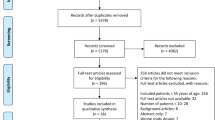Abstract
Questions/purposes
The aim of this study was to identify prognostic factors associated with a poor quality of reduction and their relationships.
Methods
Data from medical charts for all patients admitted with acetabular fractures operated by open reduction and internal fixation (ORIF) from 2005 to 2014 were extracted. A total of 156 patients with a mean age of 40.3 years were included. All patients were reviewed at six months of follow-up. The prognostic factors analyzed were clinical and radiological factors. A new radiological parameter was also studied: the scanographic roof-arc angle. Specific statistical analysis was performed using a logistic regression model.
Results
Using a multivariate analysis logistic regression model: roof impaction (p = 0.001; OR = 6.59; CI 95% [2.01–20.97]), transverse + posterior wall (p = 0.03, OR = 2.52; CI 95% [1.46–13.65]) and surgeons in training (p = 0.02; OR = 1.24; CI 95% [1.07–3.32]) were three independent prognostic factors. Lower values of medial and posterior scanographic roof-arc angle were associated with unsatisfactory reduction. A significant association between unsatisfactory reduction and posterior roof arc angle < 61° was found.
Conclusions
Three independent prognostic factors associated with a risk of unsatisfactory reduction in ORIF for acetabular fractures were identified: roof impaction, transverse + posterior wall fracture and surgeons in training. Scanographic roof-arc angle seems to be a new prognostic factor.
Level of Evidence Level 4 retrospective study


Similar content being viewed by others
References
Judet R, Judet J, Letournel E (1964) Fractures of the acetabulum: classification and surgical approaches for open reduction. Preliminary report. J Bone Joint Surg Am 46:1615–1646
Matta JM, Merritt PO (1988) Displaced acetabular fractures. Clin Orthop Relat Res 230:83–97
Tonetti J (2013) Management of recent unstable fractures of the pelvic ring. An update conference supported by the club bassin cotyle. (pelvis-acetabulum club). Orthop Traumatol Surg Res 99:S77–S86. doi:10.1016/j.otsr.2012.11.013
Kreder HJ, Rozen N, Borkhoff CM, Laflamme YG, McKee MD, Schemitsch EH, Stephen DJ (2006) Determinants of functional outcome after simple and complex acetabular fractures involving the posterior wall. J Bone Joint Surg Br 88:776–782
Bhandari M, Matta J, Ferguson T, Matthys G (2006) Predictors of clinical and radiological outcome in patients with fractures of the acetabulum and concomitant posterior dislocation of the hip. J Bone Joint Surg Br 88:1618–1624
Wright R, Barrett K, Christie MJ, Johnson KD (1994) Acetabular fractures : long-term follow-up of open reduction and internal fixation. J Orthop Trauma 8:397–403
Øvre S, Madsen JE, Røise O (2008) Acetabular fracture displacement, roof arc angles and 2 years outcome. Injury 39:922–931. doi:10.1016/j.injury.2007.12.006
Murphy D, Kaliszer A, Rice J, McElwain JP (2003) Outcome after Acetabular fracture. Prognostic factors and their inter-relationships. Injury 34:512–517
Borrelli J Jr, Ricci WM, Steger-May K, Totty WG, Goldfarb C (2005) Postoperative radiographic assessment of acetabular fractures. A comparison of plain radiographs and CT scans. J Orthop Trauma 19:299–304
Letournel E (1980) Acetabulum fractures: classification and management. Clin Orthop 151:81–106
Matta JM, Anderson LM, Epstein HC, Hendricks P (1986) Fractures of the acetabulum: a retrospective analysis. Clin Orthop 205:241–250
Matta JM (1996) Fractures of the acetabulum: accuracy of reduction and clinical results in patients managed operatively within three weeks after the injury. J Bone Joint Surg Am 78:1632–1645
Olson SA, Matta JM (1993) The computerized tomography subchondral arc: a new method of assessing acetabular articular continuity after fracture (a preliminary report). J Orthop Trauma 7:402–413
Chuckpaiwong B, Suwanwong P, Harnroongroj T (2009) Roof-arc angle and weight-bearing area of the acetabulum. Injury 40:1064–1066. doi:10.1016/j.injury.2009.01.016
Ferguson TA, Patel R, Bhandari M, Matta JM (2010) Fractures of the acetabulum in patients aged 60 years and older: an epidemiological and radiological study. J Bone Joint Surg Br 92:250–257. doi:10.1302/0301-620X.92B2.22488
Anglen JO, Burd TA, Hendricks KJ, Harrison P (2003) The ‘Gull sign”: a harbinger of failure for internal fixation of geriatric acetabular fractures. J Orthop Trauma 17:625–634
Olson SA, Bay BK, Chapman MW, Sharkey NA (1995) Biomechanical consequences of fracture and repair of the posterior wall of the acetabulum. J Bone Joint Surg Am 77:1184–1192
Levine RG, Renard R, Behrens FF, Tornetta P 3rd (2002) Biomechanical consequences of secondary congruence after both-column acetabular fracture. J Orthop Trauma 16:87–91
Giannoudis PV, Grotz MR, Papakostidis C, Dinopoulos H (2005) Operative treatment of displaced fractures of the acetabulum. A meta-analysis. J Bone Joint Surg Br 87:2–9
Jaskolka DN, Di Primio GA, Sheikh AM, Schweitzer ME (2014) CT of preoperative and postoperative acetabular fractures revisited. J Comput Assist Tomogr 38:344–347. doi:10.1097/RCT.0b013e3182ab384a
Kim JW, Herbert B, Hao J, Min W, Ziran BH, Mauffrey C (2015) Acetabular fractures in elderly patients: a comparative study of low-energy versus high-energy injuries. Int Orthop 39:1175–1179. doi:10.1007/s00264-015-2711-0
Mears DC, Velyvis JH, Chang CP (2003) Displaced acetabular fractures managed operatively: indicators of outcome. Clin Orthop Relat Res 407:173–186
Cimerman M, Kristan A (2007) Preoperative planning in pelvic and acetabular surgery : the value of advanced computerised planning modules. Injury 38:442–449
Simon P, von Roth P, Perka C (2015) Treatment algorithm of acetabular periprosthetic fractures. Int Orthop 39:1995–2003. doi:10.1007/s00264-015-2968-3
Bronsema E, te Stroet MA, Zengerink M, van Kampen A, Schreurs BW (2014) Impaction bone grafting and a cemented cup after acetabular fracture. Int Orthop 38:2441–2446. doi:10.1007/s00264-014-2411-1
Author information
Authors and Affiliations
Corresponding author
Ethics declarations
Conflict of interest
The authors declare that they have no competing interests concerning this article.
Rights and permissions
About this article
Cite this article
Boudissa, M., Ruatti, S., Kerschbaumer, G. et al. Part 2: outcome of acetabular fractures and associated prognostic factors—a ten-year retrospective study of one hundred and fifty six operated cases with open reduction and internal fixation. International Orthopaedics (SICOT) 40, 2151–2156 (2016). https://doi.org/10.1007/s00264-015-3070-6
Received:
Accepted:
Published:
Issue Date:
DOI: https://doi.org/10.1007/s00264-015-3070-6




